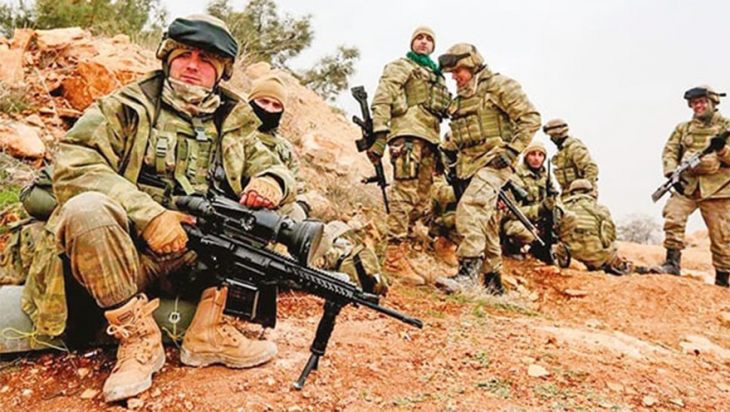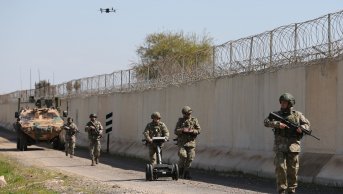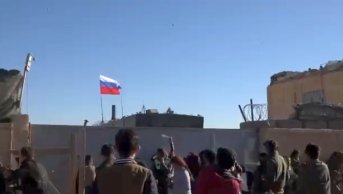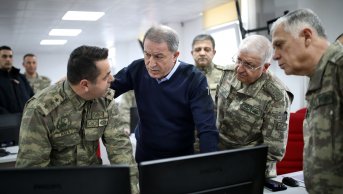Afrin Operation may be the beginning of the end for YPG/PKK

The Afrin operation that Turkey has launched in Syria in the context of its fight against YPG/PKK is about to complete its first month. The Afrin operation is probably planned to consist of several phases. The first objective of the operation is to create a safe corridor that would enclose the whole borderline in order to ensure the safety of the settlements located on the Turkish side of the border. Entering into Syria from 8 different points in line with this purpose, the Turkish Armed Forces (TSK) and the Free Syrian Army (FSA) forces began to unite these small points over time. As of the first month of the operation, the corridor between the northern and western parts of Afrin has started being formed. In the western front, there exist two substantial settlements regarding the formation of the corridor. These are Raco in the northwest and Jindires in the southwest. Both towns are larger in terms of population and geographical area than the settlements TSK and FSA have brought under control so far. Capturing Raco and Jindires may be more difficult, but after these operations have ended, the YPG/PKK may be said to first go through a major psychological collapse and then the central road to Afrin would be opened to a large extent. It is seen that Jindires is among the first military targets in the upcoming days. As a relatively large settlement, it will require a military operation on an urbanized terrain and therefore the Turkish forces that are experienced in the fight against PKK in Turkey are currently being deployed to the region. Following the formation of a safe corridor along the entire border, a second attempt will be made to gain depth into the region. In this way, TSK and FSA will take control of the area with an approximate depth of 20-30 km as indicated by Prime Minister Yıldırım before the operation was launched. The third phase of the operation, on the other hand, is the encirclement of the Afrin city center and the beginning of the city war.
Until this stage, the operation seems to be proceeding slowly but steadily. Compared to the Euphrates Shield Operation, settlements are more slowly liberated from the terrorist organization. The main reason for this is the fact that the Euphrates Shield region has a flat land structure on the whole whereas the Afrin region consists of hilly areas. Besides, the number of militants of the YPG/PKK was estimated to be 8-10 thousand before the operation started. This number is much higher than the number of terrorists the TSK and FSA fought in the Euphrates Shield Operation. The YPG/PKK is more likely to have advanced weapons such as anti-tank missiles and portable air defense missiles compared to Daesh. Ultimately, it seems that the YPG/PKK has been preparing itself for a possible war of defense for a long time and put the military tactic it learned from Daesh into practice in Afrin. The emplacement TSK has captured from YPG/PKK and the interconnected tunnels can be given as examples of this very tactic.
The only risk factor for Turkey is not in the military sense. Turkey may probably not face so much regional opposition during the first stage of the operation. However, Iran and the Syrian regime might begin to voice their opposition a little louder as Turkey is headed towards upcountry from the borderline. Both actors will interpret a total TSK/FSA-control in Afrin as an increase in pressure upon Aleppo. What’s more, Iran will not be eager to share with FSA the borders of the Nubl and al-Zahraa settlements which are under the control of the Iranian militiamen whom Iran supports. In the same way, the entire liberation of Afrin from YPG will mean the FSA control of a holistic and wide area as Afrin provides the geographical link between the Euphrates Shield region and Idlib. This could undermine the plans of the regime which does not intend to make too much concession in the political settlement.
For all these reasons, new evaluations and negotiations may come to the forefront as the second phase of the Afrin operation starts. The biggest plan Iran and the regime have in mind is that the increasing military pressure on YPG by Turkey would prompt the organization to pass the city on to the regime. Sipan Hamo from YPG has recently announced that they want the regime forces to enter Afrin. In this regard, it is seen in the press that the negotiations between the regime and YPG have begun. It is alleged that YPG agreed upon the entrance of the Syrian army into the Afrin area, but the regime demanded that all YPG weapons would be surrendered to the Syrian army as a prerequisite. YPG did not accept this precondition and consequently, negotiations failed for the time being. Even though the talks failed, YPG may be more likely to reach an agreement if Turkey moves towards the city center.
A deal between the regime and YPG deal in Afrin is an improvement that fits so well to the Russian game plan on the field. Russia has already been putting pressure on YPG for a long time to deliver Afrin to the regime. If Russia can achieve this, it will think that its efforts to estrange YPG/PKK from the US influence has begun to yield results and it has studied out a very appropriate solution to the difficulty of finding a balance between Turkey and YPG.
Thus, carrying out the Afrin operation Turkey should be prepared about how to act in the event of such a development. For the said scenario would stonewall the Turkish progress towards the city center. That Turkey directly targets regime would mean the Russian and Iranian involvement in the matter. On the other hand, the main goal of removing YPG from Afrin will be attained. Moreover as there would be no necessity of entering the city center, such a scenario can be seen as an opportunity for some reasons such as the absence of civilian loss and the exemption from several risks of a city war. Nevertheless, Turkey has said that in any case, the first choice is that TSK and FSA obtain the full control of the entire Afrin.
Whichever scenario takes place, it is ultimately only a matter of time for the YPG/PKK existence in Afrin to come to an end. This may be the beginning of the end for the YPG. YPG reached its natural border with the completion of its operations in eastern Syria. That's precisely why the US has recently announced that it will create border protection force with the help of YPG elements. This indicates the transition of the YPG / PKK from the expansion/enlargement phase to the defense phase. The Afrin operation is the most serious challenge in this respect and the organization has begun to lose space for the first time. It must be said that the only rival of YPG/PKK is not Turkey. First and above all, the demographic structure in the places that it controls works unfavorably of YPG and its legitimacy is based on a very weak ground. The structure that resorts to the use of force and creates a network of interest becomes very fragile within itself and is easily breakable from the inside in the event of a possible weakness. Secondly, it is understood with the end of the struggle against Daesh that the real intention of the US and the YPG/PKK is to create a new reality in Syria and to give this reality a political status. The number of regional actors that will be disturbed by this situation is too many. The fact that the regime, Iran and Russian elements initiated military operation against the YPG region in the Deir ez-Zor region is also a result of this perspective. The US responded quite strongly to this attack and killed over 100 warriors. Nevertheless, it seems that the YPG-controlled areas under US influence will face more and more challenges. The Afrin operation symbolizes the beginning of the decline for YPG which has seen the peak point.
This article has been published in Star Newspaper on February 18, 2018 with the title “Afrin Operasyonu YPG/PKK için Sonun Başlangıcı (Afrin Operation may be the beginning of the end for YPG/PKK”








